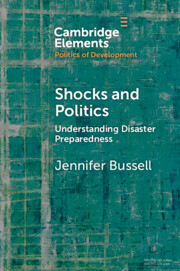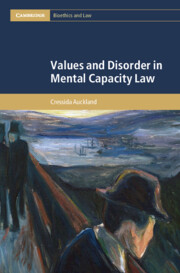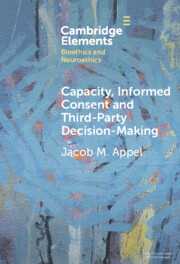Refine search
Actions for selected content:
148 results
Chapter 27 - Legal Issues in Dementia
- from Section 3 - Treatment of the Dementias
-
-
- Book:
- The Behavioral Neurology of Dementia
- Published online:
- 17 November 2025
- Print publication:
- 11 December 2025, pp 466-482
-
- Chapter
- Export citation
Challenges in decision-making capacity in the acute hospital setting: two years on from the implementation of the Assisted Decision-Making (Capacity) Act 2015
-
- Journal:
- Irish Journal of Psychological Medicine , First View
- Published online by Cambridge University Press:
- 10 October 2025, pp. 1-5
-
- Article
-
- You have access
- Open access
- HTML
- Export citation
5 - Voice
-
- Book:
- Building Social Mobility
- Published online:
- 15 September 2025
- Print publication:
- 02 October 2025, pp 115-146
-
- Chapter
- Export citation
1 - The United States and International State-Building Efforts
-
- Book:
- Hierarchy and the State
- Published online:
- 20 August 2025
- Print publication:
- 02 October 2025, pp 1-22
-
- Chapter
- Export citation
2 - The Map
-
- Book:
- Disability, Human Rights, and Contract Law
- Published online:
- 06 August 2025
- Print publication:
- 31 July 2025, pp 9-33
-
- Chapter
- Export citation
Canadian mental health laws: a review of involuntary admission and treatment pending appeal
-
- Journal:
- CNS Spectrums / Volume 30 / Issue 1 / 2025
- Published online by Cambridge University Press:
- 07 July 2025, e56
-
- Article
-
- You have access
- Open access
- HTML
- Export citation
3 - Education and the 100-Year Life
- from Part I - Implications across the Legal System
-
-
- Book:
- Law and the 100-Year Life
- Published online:
- 13 May 2025
- Print publication:
- 29 May 2025, pp 39-51
-
- Chapter
-
- You have access
- Open access
- HTML
- Export citation
Chapter 3 - Complete Passive Activity
-
- Book:
- Aristotle on the Nature and Causes of Perception
- Published online:
- 01 May 2025
- Print publication:
- 22 May 2025, pp 72-99
-
- Chapter
-
- You have access
- Open access
- HTML
- Export citation
Neuroethics and treatment without consent
-
- Journal:
- CNS Spectrums / Volume 30 / Issue 1 / 2025
- Published online by Cambridge University Press:
- 11 April 2025, e39
-
- Article
-
- You have access
- Open access
- HTML
- Export citation
Health technology assessment capacity to support Zambia’s health benefits package reform policy
- Part of
-
- Journal:
- International Journal of Technology Assessment in Health Care / Volume 41 / Issue 1 / 2025
- Published online by Cambridge University Press:
- 28 February 2025, e15
-
- Article
-
- You have access
- Open access
- HTML
- Export citation

Shocks and Politics
- Understanding Disaster Preparedness
-
- Published online:
- 06 February 2025
- Print publication:
- 06 February 2025
-
- Element
- Export citation
Departmental practice on informed consent in radiotherapy departments: a UK evaluation
- Part of
-
- Journal:
- Journal of Radiotherapy in Practice / Volume 24 / 2025
- Published online by Cambridge University Press:
- 09 January 2025, e1
-
- Article
-
- You have access
- Open access
- HTML
- Export citation
3 - The Three Styles of Authoritarianism
- from Part II - A Tale of Three Cities
-
- Book:
- The Authoritarian Commons
- Published online:
- 21 December 2024
- Print publication:
- 09 January 2025, pp 27-43
-
- Chapter
- Export citation
5 - Extremization of Mutual Information: Capacity Saddle Point
- from Part I - Information Measures
-
- Book:
- Information Theory
- Published online:
- 09 January 2025
- Print publication:
- 02 January 2025, pp 91-105
-
- Chapter
- Export citation
20 - Channels with Input Constraints and Gaussian Channels
- from Part IV - Channel Coding
-
- Book:
- Information Theory
- Published online:
- 09 January 2025
- Print publication:
- 02 January 2025, pp 402-418
-
- Chapter
- Export citation
Finely quasiconformal mappings
- Part of
-
- Journal:
- Proceedings of the Royal Society of Edinburgh. Section A: Mathematics , First View
- Published online by Cambridge University Press:
- 23 December 2024, pp. 1-25
-
- Article
- Export citation

Values and Disorder in Mental Capacity Law
-
- Published online:
- 25 October 2024
- Print publication:
- 27 June 2024
Introduction
-
- Book:
- Values and Disorder in Mental Capacity Law
- Published online:
- 25 October 2024
- Print publication:
- 27 June 2024, pp 1-15
-
- Chapter
- Export citation

Capacity, Informed Consent and Third-Party Decision-Making
-
- Published online:
- 03 June 2024
- Print publication:
- 17 October 2024
-
- Element
- Export citation
4 - Networks and Discrete Analysis
- from Part I - Tools and Theory
-
- Book:
- Harmonic Functions and Random Walks on Groups
- Published online:
- 16 May 2024
- Print publication:
- 23 May 2024, pp 117-158
-
- Chapter
- Export citation

